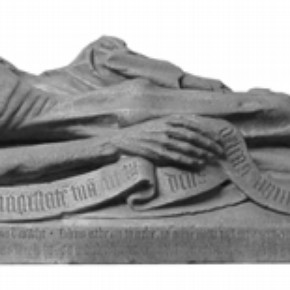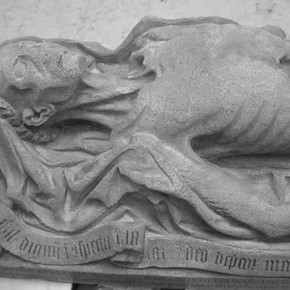Conservation Journal
Autumn 2003 Issue 45
Conservation of an English cadaver tomb
Introduction
The effigy, dating from the 1450s, forms part of a tomb for John Baret and is on loan to the Museum for the exhibition 'Gothic: Art for England 1400-1547' from St Mary’s Church in Bury St Edmunds, Suffolk.
The tomb effigy is carved in limestone. It depicts an emaciated cadaver in a shroud and is surrounded by a scroll with incised gothic lettering in Latin. The cadaver tomb was a continental form of funeral monument and was adopted in England in the 1420s.
This effigy was originally fully polychromed but now there are just small traces remaining in various areas: the inlaid paint of the lettering, which is black and red with green for the capitals; the very faded traces of flesh tones; traces of red pigment on the base of the tomb. It is interesting to note the traces of green and red veins carefully painted onto the flesh tones which are found in several areas but are particularly evident on the neck. These remains of paint give us an idea of the dramatic and crude visual effect of this effigy on its original state.1
Condition
The limestone is generally in good condition although it has suffered erosion and abrasion through the centuries, which has affected mainly the most exposed areas of the carving such as the head, legs and the folds of the shroud. There are numerous old small chips and dents on the whole surface of the stone and a larger loss corresponding to the left hand and forearm.
The whole tomb stone was completely covered with a thick layer of dirt and dust with heavy build-up in deep areas of the carving. A few localised small drips of paint, cement and plaster were found on the base, traces of wax on the scroll and small pencil marks and scratched graffiti on the feet area. The polychromy is stable although in some areas of the flesh tones, there are signs of flaking paint and powdery pigment.
Conservation Treatment
It is unusual for conservators in the Museum to treat objects coming in on loan; the nature of this exhibition, however, with a large number of objects from parish churches, meant that in some cases, such as with this effigy, we were requested to carry out preparatory conservation treatment.
The main aims of this conservation treatment were to clean the tomb in order to recover the warm colour of the limestone enhancing the main features of the carving and lettering as well as consolidating the few traces of paint when necessary. Sadly the timescale did not allow for in depth analysis of the paint layer, which would surely be of interest.
The first step was a mechanical dry cleaning with a soft brush and vacuum cleaner in order to remove the bulk of the dirt layer. This was followed by an application of powdered rubber with brushes of different sizes and shapes to remove as much dirt as possible, completing the process with a Wishab acidfree sponge of soft grain. Then the whole effigy was vacuum cleaned again to remove the remains of rubber and dirt. The small deposits of plaster and paint were removed with a scalpel and a small chisel was used to remove the cement.
The second stage included wet cleaning in order to remove traces of wax, particularly on the scroll area, and any ingrained dirt which had proved difficult to remove during the dry cleaning. For this purpose a non-ionic detergent, Triton X-100 2% in de-ionised water/white spirit (1:1) was applied with soft brushes rinsing it with a mixture of de-ionised water/white spirit (1:1) and a moist natural sponge. Special care was taken in the areas with paint traces. These were cleaned with cotton wool swabs dampened with white spirit. After this cleaning, the stone has remained discoloured. This is because the level to which cleaning was taken was chosen because of the porosity of the stone and the absorption of the dirt into the pores. The decision was based on both an aesthetic judgement and the time limit imposed by the exhibition timetable.
Some of the remains of the original polychromy, particularly the flesh tones, were slightly powdery and flaky on small areas. A solution of the acrylic dispersion Plextol 5% was applied as a consolidant through acid-free Japanese tissue with a soft brush after pre-wetting with ethanol/de-ionised water 1:1. The excess was removed with a moist cotton wool swab before removing the tissue.
The chromatic reintegration was carried out with Rowney acrylic colours using the technique of flat washes of colour to tone down chips and dents on the stone as well as the light patches left behind after the removal of surface deposits.
Reference
1 Marks, R & Williamson, P (eds), Gothic: Art for England 1400-1547, London: V&A Publications, 2003.
Autumn 2003 Issue 45
- Editorial
- Planning 'Gothic: Art for England 1400-1547'
- Climate monitoring of objects for the 'Gothic: Art for England' exhibition
- The October Labour
- Conservation of an English cadaver tomb
- Decision making: Technical information revealed
- V&A in the regions: Conservation Summer Schools at the University of Derby
- Elizabeth Martin 1947-2003
- News from RCA/V&A Conservation
- Printer Friendly Version of Journal 45

